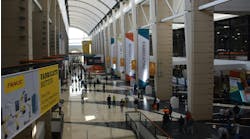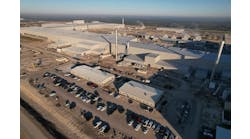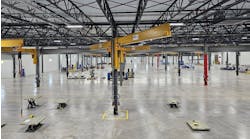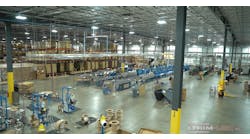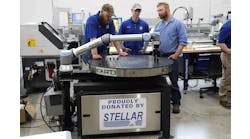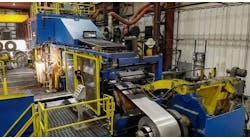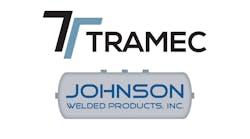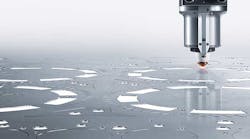New Laser-cutting technology and innovations are improving productivity, machine uptime, reliability, consistency, and decreasing setup time
Modern laser cutting has come a long way in recent years, with improvements in productivity and uptime changing the performance and capabilities of the latest generation of machines.
In a webinar, “Innovation in Laser-Cutting Technology,” Stefan Fickenscher, product manager of Trumpf’s TruLaser Product Group, said that due to higher laser powers, faster controls, and innovative features, the machines from years ago are not comparable to today’s cutting machines.
“By definition, innovation is the application of new solutions that meet new requirements or existing market needs,” Fickenscher said. “This is accomplished through more effective products, processes, services, technologies, or ideas.
“The main areas of improvement for a laser-cutting machine are increased productivity and cycle time, greater machine uptime, decreased setup time, and improved reliability and consistency.”
For example, he said Trumpf introduced its TruLaser 3030 in 1995, but it is a completely different kind of machine today.
Today’s TruLaser 3030 machine, equipped with a 6kW TruFlow resonator, has a single cutting head strategy—which means having the capability to use one cutting head for all kinds of materials and material thicknesses.
“To get an optimal cutting result in different material thicknesses, the focus point of the laser beam must be set to a defined point relative to the work-piece surface,” he said. “In the past, this was achieved by using multiple cutting heads or multiple lens cassettes.
“Today’s latest-technology machines use only one cutting head and instead of using multiple heads or cassettes, the machines automatically adapt the diameter of the raw beam to simulate the different focal positions to have the right beam angle and kerf width for every material and thickness.”
A push of a button is enough to release or lock the head in position. No additional tools are required and no hoses have to be connected.
“These modern cutting heads carry much more technology than just the lens,” he said. “Every head is equipped with an RFID chip that communicates and exchanges information like the focus adjustment with the machine control. To clean the lens, the head can be disassembled without additional tools. To protect the head in case of a collision, it is spring-loaded and will just swing out of its position if a collision takes place.”
Fickenscher said a single head clearly improves the machine productivity because there is less waiting time between jobs. Machine uptime is increased because the time that was used for head changes before can now be used as additional production time.
As no head change is necessary, the setup time is decreased, and contamination during the lens changing process is eliminated, which results in greater process reliability.
How much additional production time can be achieved? By calculating four cutting head changes in a two-shift operation with an average four-minute change time, including waiting, 113 hours of added production hours per year can be achieved.
Then there’s the automatic nozzle changer.
A fair amount of nozzles are necessary to ensure the full flexibility of the system to cover a wide range of materials when switching materials or processing. A nozzle change takes about 60 seconds.
To optimize the machine uptime, the automatic nozzle change takes place parallel to the pallet change, needing just 21 seconds. For process security reasons, the nozzle position is cleaned with an air purge before nozzles are put in and out.
“With an automatic nozzle changer, higher machine uptime is a given, as the nozzles are always changed only when necessary without waiting times,” he said. “There’s less setup, as no manual nozzle changes are necessary. And there’s higher reliability for an unmanned operation. The continuous operation of the automatic nozzle changer creates additional production time, as downtime for the operator is eliminated.”
He said the automatic nozzle-centering function is something almost every laser operator was waiting for.
Part-processing times can not only be reduced by faster drives and axis movements, but also with an improved piercing process,” Fickenscher said. “The PierceLine sensor monitors and regulates the piercing process at any time and adjusts the laser power level within boundaries to pierce the material as fast and smooth as possible and to avoid the volcano effect where spatter emerges from the material. Additional, the sensor detects the end of the piercing to start the cutting process immediately after.
“This achieves a faster piercing process and smaller piercing holes due to less material expulsion and piercing residues. Piercing with different height to lens protects the lens from spatter. There’s less heat input into the material.”
Heavier steel—thicknesses of a half inch or more—may require supplemental cooling, Fickenscher said. He cited his company’s CoolLine system which sprays a mist of water during the cutting process to help moderate the heat. The CoolLine uses a separate cutting head with an integrated water supply and a so-called shower nozzle.
“There is increased process stability when cutting low-quality material and reduced material costs when cutting high-quality material,” Fickenscher said. “By cooling the material, it is possible minimize the local overheating effect, thereby enabling fabricators to cut smaller, more filigree contours in higher sheet thicknesses. These smaller contours can not only be used in the part but also to nest parts closer together. By doing so, more parts can be nested on the same sheet and a better material utilization can be achieved.”
A feature to automatically check the contamination level of the lens is another advance that laser manufacturers have developed. Trumpf’s LensLine uses a light sensor to tell the operator whether or not it is necessary to clean it.
“A contaminated lens results in bad cut quality and slower cutting speed, meaning the full machine capability is not utilized,” he said. “Most customers proactively clean the lens—every beginning of a shift to be on the safe side. With LensLine, instead of cleaning the lens proactively, the lens can be checked in a certain sequence and will only be cleaned when required. In the case of a cutting problem, LensLine is a great feature to check fast if the problems are lens related.” ♦
